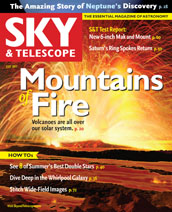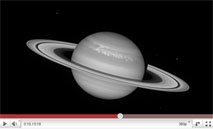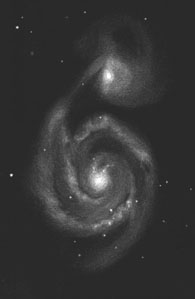Sky & Telescope's July 2011 issue is now available to digital subscribers. It has already started to ship to print subscribers, and is officially on-sale at newsstands starting May 31st.
Click here to read the latest issue if you're a digital subscriber.
Click here to find out more about digital subscriptions.

July 2011 S&T
As a dedicated telescopic observer, I ofen find the observing articles to be the most interesting part of our magazine, but this time I was eager to read the cover story, a survey of volcanoes throughout the solar sytem, including all the rocky planets as well as many of the moons.
I have eagerly followed the news as planetary space probes have uncovered ever more evidence of volcanism, but I had before considered approaching the solar system specifically from the point of view of its volcanoes. Nor had I realized how much volcanic activity on one world can tell us about another world, nor how much controversy exists about whether volcanic activity has taken place recently -- or even currently -- on Mars and Venus.

Click on the image above to watch a video of Saturn's rotation, complete with ring spokes.
NASA / ESA / STSci / S&T: Sean Walker
Speaking of exotic planetary phenomena, S&T contributing editor William Sheehan has an article on one of the strangest — the "spokes" that are sometimes observed in Saturn's B ring. This article combines all of Sheehan's remarkable strengths. First is the historian who summarizes the record of spoke sightings starting with the first barely credible reports in the 19th century, through their confirmation by the Voyager probes in the 1980s, and on to the current photos through amateur and professional telescopes. Then there's the scientist who explains why the spokes defied explanation until 2006, when they were convincingly tied to thunderstorms in the planet's upper atmosphere. And finally, the skilled planetary observer who explains why right now is an ideal time to attempt this most challenging observation.

Howard Banich
Observing challenges in the July issue aren't limited to the planets; there's also an article by the well-known visual observer Howard Banich, who spent 6 nights sketching Messier 51, the Whirlpool Galaxy, at the eyepiece of his 28-inch Dob. Observing this galaxy's spiral arms is a rite of passage for deep-sky observers, but few people take the time to push their quest one level deeper, looking for subtle details within the arms. Banich's final sketch is extraordinary — possibly the most detailed portrait ever of a galaxy as seen by the human eye.
Back to WiIlliam Sheehan. He has a second article in this issue, written together with professional astronomer and science writer C. Renée James. This July, Neptune will have completed a full orbit around the Sun since its discovery in 1846. James and Sheehan recount how Neptune was discovered based on its gravitational perturbation of Uranus's orbit. The story is well known, but this article gives a fresh perspective on it, and on the international controversy that surrounded the discovery.
This is just a smattering of the riches in the July 2011 issue of Sky & Telescope. There's also a test report on a remarkable new telescope and mount from iOptron, the usual great observing articles by columnists Sue French, Fred Schaaf, and Gary Seronik, and an article on new techniques for creating photo mosaics. Finally, I was particularly pleased by Seronik's lucid explanation how and why to collimate the secondary mirror in a Newtonian telescope — a simple subject that has engendered unwarranted confusion and misunderstanding.
Click here to see more about the July issue.
 0
0
Comments
You must be logged in to post a comment.